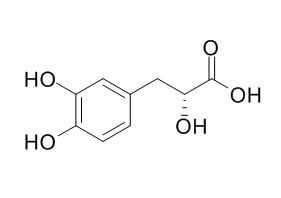Natural Products
Danshensu
| Catalog No. | CFN99539 |  |
| CAS No. | 22681-72-7 | |
| Molecular Weight: | 198.17 | |
| Molecular Formula | C9H10O5 | |
| DBs | [PubChem]:274950614 [ChEMBL]: [PCIDB]: |
Standard InChI:
InChI=1S/C9H10O5/c10-6-2-1-5(3-7(6)11)4-8(12)9(13)14/h1-3,8,10-12H,4H2,(H,13,14)/t8-/m1/s1
Biological Activity
Danshensu from the aqueous extract of Salvia miltiorrhiza (Danshen), has protective effects against homocysteine-induced endothelial dysfunction.[1]
Shenge, made of puerarin (isolated from Pueraria lobata Ohwi., also called Kudzu) and Danshensu (isolated from the Chinese herb, Salvia miltiorrhiza), exerts significant cardioprotective effects against acute ischemic myocardial injury in rats, likely through its antioxidant and anti-lipid peroxidation properties, and thus may be an effective and promising medicine for both prophylaxis and treatment of ischemic heart disease.[2]
Danshensu and salvianolic acid B are efficient radical scavengers and antioxidants, and salvianolic acid B is superior to danshensu, their radical scavenging and antioxidant properties might have potential applications in food and healthcare industry.[3]
Danshensu has neuroprotective effects, it may provide a potential alternative for the prevention of cognitive impairment associated with diabetes by attenuating AGE-mediated neuroinflammation; it can enhance HO-1 expression to suppress 6-OHDA-induced oxidative damage via PI3K/Akt/Nrf2 signaling pathways, and 6-OHDA-induced dopaminergic neuronal loss in zebrafish could be reduced by danshensu, further supporting the neuroprotective potential of danshensu.[4,5]
Danshensu could provide significant cardioprotection against MI/R injury, and the potential mechanisms might to suppression of cardiomyocytes apoptosis through activating the PI3K/Akt and ERK1/2 signaling pathways.[6]
Danshensu exerts its anxiolytic-like properties, in part, through dopaminergic neurotransmitter signaling.[7]
Chronic treatment with danshensu can prevent/attenuate the formation of atherosclerosis, the potential mechanisms include inhibited expression of representative proinflammatory cytokines and adhesion molecules in arterial endothelia, and changes in homocysteine and circulating molecules that control vascular contraction/relaxation via endothelial cells (eg, endothelin and NO) .[8]
Product
References
[1] Chan K, Chui S H, Wong D Y L, et al. Life Sci, 2004, 75(26):3157-71.
[2] Wu L, Qiao H, Li Y, et al. Phytomedicine, 2007, 14(10):652-8.
[3] Zhao G R, Zhang H M, Ye T X, et al. Food Chem Toxicol, 2008, 46(1):73-81.
[4]Tian W, Fu F, Bing H, et al. J Neuroimmunol, 2012, 245(1-2):79-86.
[5] Chong C M, Zhou Z Y, Razmovski-Naumovski V, et al. Neurosci Lett, 2013, 543:121-5.
[6] Yin Y, Guan Y, Duan J, et al. Eur J Pharmacol, 2013, 699(1-3):219-26.
[7] Kwon G, Kim H J, Park S J, et al. Life Sci, 2014, 101(1-2):73-8.
[8] Rui-xue, YANG, Shan-ying, et al. Acta Pharmacol Sin, 2010, 31(10):1395-400.
[9] Xiao-Li L I, Li XR , Wang L J, et al. Chinese Traditional Patent Medicine, 2008, 30(1):77-80.
Product Use Citation





